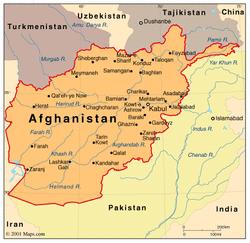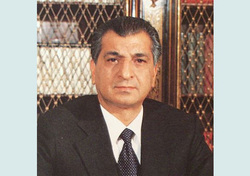The Soviet Invasion of Afghanistan
Table of Contents
Before the Invasion
U.S. Involvement
The Invasion
Afghanistan Under Soviet Rule
Before the Invasion

(5)
In the years previous to the Soviet invasion, Afghanistan was in turmoil. Prior to 1973 it was ruled by King Mohammed Zahir Shah. However, in 1973, Shah was dethroned by a coup, and his brother-in-law Mohammed Daoud Khan became the self-appointed president of Afghanistan. Daoud was nominally a nationalist, but received extensive military and financial aid from the Soviet Union, going so far as to sign a Soviet-Afghan Friendship Treaty, which provided both military and economic support for Afghanistan. His communistic and atheistic policies angered the majority population of Muslims, and many of them joined the Mujaheddin, a rebel group. Daoud himself was killed in a military coup in 1978 and replaced by Nur Muhammad Taraki. Taraki only remained in power a few months before he was murdered and replaced by Hazifullah Amin.
Hafizullah Amin was the Prime Minister of Afghanistan at the time of the Russian invasion, having seized power from Nur Muhammad Taraki only a few months prior. Because of his communist policies, he was unpopular with the largely Muslim population. Amin was a member of the People's Democratic Party of Afghanistan, one of several factions that was vying for control of the country after its revolution and reformation in 1978. The Russian invasion was purportedly to support his failing government. (3)(4)(6)(8)(9).
Hafizullah Amin was the Prime Minister of Afghanistan at the time of the Russian invasion, having seized power from Nur Muhammad Taraki only a few months prior. Because of his communist policies, he was unpopular with the largely Muslim population. Amin was a member of the People's Democratic Party of Afghanistan, one of several factions that was vying for control of the country after its revolution and reformation in 1978. The Russian invasion was purportedly to support his failing government. (3)(4)(6)(8)(9).
U.S. Involvement
Zbigniew Brzezinski, Carter’s national security advisor, started a program in Afghanistan in early 1979 to support and train Mujaheddin (jihadist Muslims) in their efforts to overthrow the communist government. Both the CIA and British MI6 were involved in the campaign, and while it was not officially acknowledged at the time, Brzezinski later stated in an interview “That secret operation was an excellent idea. It had the effect of drawing the Russians into the Afghan trap” suggesting that part of the motivation for U.S. involvement in Afghanistan was to induce Russia to counter their efforts with a military force.(7).In the years previous to the Soviet invasion, Afghanistan was in turmoil. Prior to 1973 it was ruled by King Mohammed Zahir Shah. However, in 1973, Shah was dethroned by a coup, and his brother-in-law Mohammed Daoud Khan became the self-appointed president of Afghanistan. Daoud was nominally a nationalist, but received extensive military and financial aid from the Soviet Union, going so far as to sign a Soviet-Afghan Friendship Treaty, which provided both military and economic support for Afghanistan. His communistic and atheistic policies angered the majority population of Muslims, and many of them joined the Mujaheddin, a rebel group. Daoud himself was killed in a military coup in 1978 and replaced by Nur Muhammad Taraki. Taraki only remained in power a few months before he was murdered and replaced by Hazifullah Amin.
Hafizullah Amin was the Prime Minister of Afghanistan at the time of the Russian invasion, having seized power from Nur Muhammad Taraki only a few months prior. Because of his communist policies, he was unpopular with the largely Muslim population. Amin was a member of the People's Democratic Party of Afghanistan, one of several factions that was vying for control of the country after its revolution and reformation in 1978. The Russian invasion was purportedly to support his failing government. (3)(4)(6)(8)(9).
Hafizullah Amin was the Prime Minister of Afghanistan at the time of the Russian invasion, having seized power from Nur Muhammad Taraki only a few months prior. Because of his communist policies, he was unpopular with the largely Muslim population. Amin was a member of the People's Democratic Party of Afghanistan, one of several factions that was vying for control of the country after its revolution and reformation in 1978. The Russian invasion was purportedly to support his failing government. (3)(4)(6)(8)(9).
The Invasion
On Christmas Eve of 1979, Soviet forces began to gather in airbases in and around Afghanistan. In Kabul, a two-day airlift brought in 5,000 troops under the pretext of being invited to support Amin’s crumbling government against the rebel Mujaheddin. They took control of parts of the capital and other key locations in Afghanistan. Three days later, in an assault codenamed Operation Storm-333, Soviet forces seized the Tajibeg Palace near Kabul and despite earlier pretexts of supporting Amin, executed him, as well as his personal guards. The Soviet army reportedly suffered only 25 deaths over the course of the invasion, while over 2,000 Afghan troops were killed. By December 28, the Soviet army effectively had control of the entire country. (1)(2)(4)(6)(8).
Afghanistan Under Soviet Rule

Babrak Karmal
Immediately after Amin was killed, Babrak Karmal was put in charge. Formerly an ambassador for Afghanistan, he was exiled, then brought back by the Soviets as a puppet leader. Although Karmal and the Soviets slowed down some of the reforms that previous members of the People's Democratic Party of Afghanistan had enacted in an effort to arouse public support, the government was widely spurned. There were three attempts at coupes with harsh retaliations by the Soviet army, and continual fighting between different political factions. Afghanistan sucked military resources from the Soviet Union and provided little benefit until the Soviet Union withdrew in 1989.(2)(4).
References
(1) "Jimmy Carter: Soviet Invasion of Afghanistan Address to the Nation." The American Presidency Project. Web. 28 Sept. 2011.
(2)NewsHour, Online. "The Online NewsHour: Afghanistan and the War on Terror | The Soviet Occupation | PBS." PBS: Public Broadcasting Service. Web. 28 Sept. 2011. Web.
(3) Soviet Union. Treaty of Friendship, Good-neighbourliness, and Cooperation. 1978. Web.
(4) Amstutz, J. Bruce. Afghanistan the First Five Years of Soviet Occupation. Washington (D.C.): National Defense UP, 1986.
(5) Map: Afghanistan www.infoplease.com. Web
(6) MacEachin, Douglas. Predicting the Soviet Invasion of Afghanistan: The Intelligence Community's Report. Publication. CIA. Web.
(7) Brzezinski, Zbigniew. "The CIA's Intervention in Afghanistan." Interview. Center for Research on Globalisation. Web. http://www.globalresearch.ca
(8) "USSR's Most Famous 'special Op': Killing Afghani President — RT." RT. Web. 28 Sept. 2011.
(9) "Hafizullah Amin." Web. http://afghanland.com/history/amin.html.
(2)NewsHour, Online. "The Online NewsHour: Afghanistan and the War on Terror | The Soviet Occupation | PBS." PBS: Public Broadcasting Service. Web. 28 Sept. 2011. Web.
(3) Soviet Union. Treaty of Friendship, Good-neighbourliness, and Cooperation. 1978. Web.
(4) Amstutz, J. Bruce. Afghanistan the First Five Years of Soviet Occupation. Washington (D.C.): National Defense UP, 1986.
(5) Map: Afghanistan www.infoplease.com. Web
(6) MacEachin, Douglas. Predicting the Soviet Invasion of Afghanistan: The Intelligence Community's Report. Publication. CIA. Web.
(7) Brzezinski, Zbigniew. "The CIA's Intervention in Afghanistan." Interview. Center for Research on Globalisation. Web. http://www.globalresearch.ca
(8) "USSR's Most Famous 'special Op': Killing Afghani President — RT." RT. Web. 28 Sept. 2011.
(9) "Hafizullah Amin." Web. http://afghanland.com/history/amin.html.
